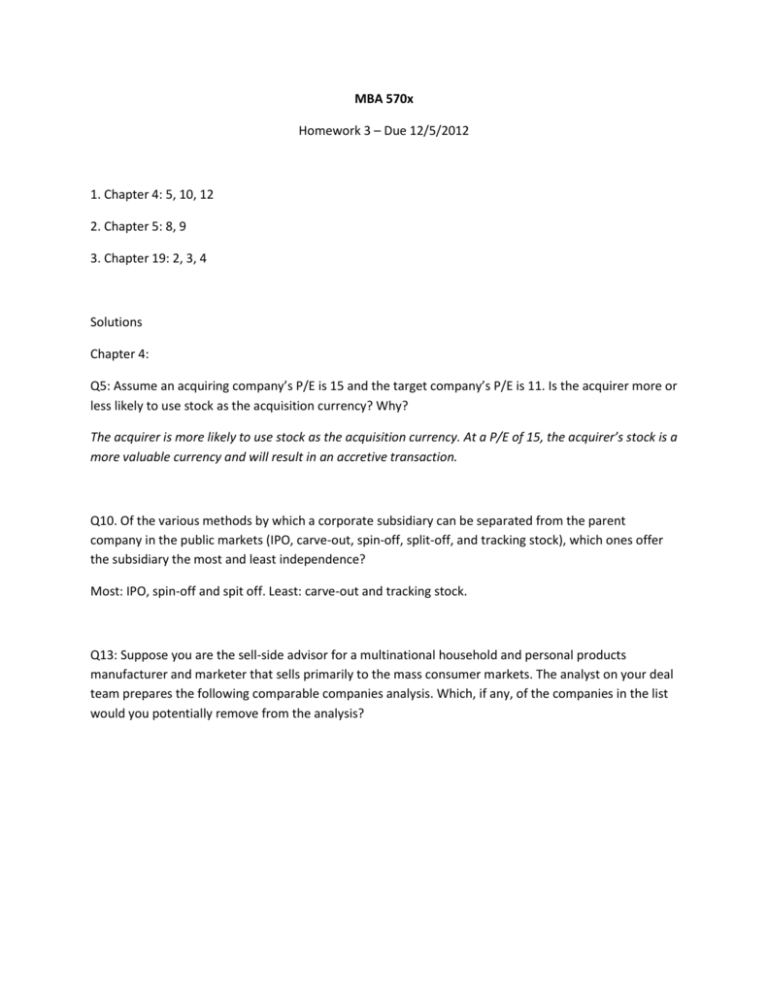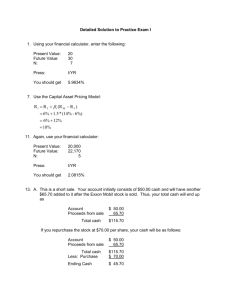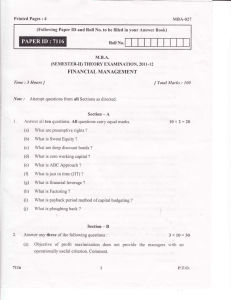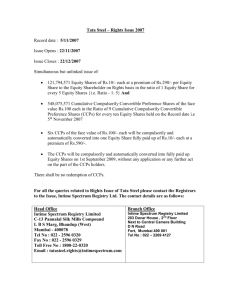MBA 570x Homework 3 – Due 12/5/2012 1. Chapter 4: 5, 10, 12 2
advertisement

MBA 570x Homework 3 – Due 12/5/2012 1. Chapter 4: 5, 10, 12 2. Chapter 5: 8, 9 3. Chapter 19: 2, 3, 4 Solutions Chapter 4: Q5: Assume an acquiring company’s P/E is 15 and the target company’s P/E is 11. Is the acquirer more or less likely to use stock as the acquisition currency? Why? The acquirer is more likely to use stock as the acquisition currency. At a P/E of 15, the acquirer’s stock is a more valuable currency and will result in an accretive transaction. Q10. Of the various methods by which a corporate subsidiary can be separated from the parent company in the public markets (IPO, carve-out, spin-off, split-off, and tracking stock), which ones offer the subsidiary the most and least independence? Most: IPO, spin-off and spit off. Least: carve-out and tracking stock. Q13: Suppose you are the sell-side advisor for a multinational household and personal products manufacturer and marketer that sells primarily to the mass consumer markets. The analyst on your deal team prepares the following comparable companies analysis. Which, if any, of the companies in the list would you potentially remove from the analysis? Comparable Companies Analysis $ in billions Alberto Culver Co. Beiersdorf AG Chattem Inc. Church & Dwight Co. Colgate-Palmolive Co. Henkel KGaA Nvtg Prf McBride PLC Prestige Brands Holdings Inc. Procter & Gamble Co. Reckitt Benckiser Group PLC Enterprise Location Market Cap Value (EV) U.S. $2.4 $2.3 Germany $15.9 $15.1 U.S. $1.4 $1.7 U.S. $3.9 $4.2 U.S. $42.8 $41.9 Germany $21.6 $26.2 U.K. $0.3 $0.9 U.S. $0.4 $1.0 U.S. $232.2 $268.1 U.K $38.1 $41.3 LTM Revenue $1.5 $8.0 $0.4 $2.1 $13.4 $19.3 $1.2 $0.3 $77.9 $10.3 LTM LTM EBITDA EBITDA Margin $0.2 11.2% $1.2 14.6% $0.1 29.4% $0.3 15.6% $2.9 21.8% $2.5 13.0% $0.1 8.7% $0.1 31.5% $18.9 24.3% $2.7 26.1% EV / Revenue 1.5x 1.9x 4.4x 2.0x 3.1x 1.4x 0.8x 3.0x 3.4x 4.0x EV / EBITDA 13.1x 12.9x 15.1x 12.7x 14.4x 10.5x 9.2x 9.6x 14.2x 15.4x P&G may be too big; Prestige may be too small; McBride only sells in Europe (and may be too small). Chapter 5: Q8: An investor lends 10,000 shares of ABC for two months when the stock is at $50 and requires 102% cash collateral. The market interest on cash collateral is 4.0%. The rebate rate on ABC shares is 2.5%. Calculate the combined profit for the stock lender and investment bank. 10,000 x $50 x 102% = $510,000 cash collateral. $510,000 x (4% / 6) = $3,400 market interest. $510,000 x (2.5% / 6) = $2,125 rebate amount. $3,400 - $2,125 = $1,275. Q9: Suppose Company XYZ has an average daily trading volume of 1 million shares and shows a current short interest ratio of 3.0. It currently has a $100 million convertible outstanding that is convertible into 4 million shares. The hedge ratio on convertible bond is 55%, which means hedge funds investing in the security will sell short 55% of the shares underlying the convertible. Assume all investors in the convertible are hedge funds. Based on this information, estimate the adjusted short interest ratio that is a better representation of the current “bearish sentiment” on the stock. 0.8 short interest ratio: - 3.0 x 1 million shares = 3 million shares currently sold short - 4 million shares x 55% = 2.2 million shares sold short by hedge funds - 3 - 2.2 = 0.8 million sold short that is unrelated to hedge funds’ convertible hedging activity - 0.8 million / 1 million = 0.8 short interest ratio Chapter 19 Q2: What are similarities and differences in the compensation structure for private equity funds and hedge funds? Both generally charge a 2% management fee, although with private equity funds, the balance the 2% is calculated on may change in the later years of the fund. While both charge 20% performance fees (carried interest), the specific mechanics are different (high water marks for hedge funds; hurdles and preferred returns for private equity funds). Finally, there are no ancillary fees charged to investors by hedge funds. Q3: Based on the fee structure in Exhibit 19.4, calculate the amount of profits allocated to the General Partner and Limited Partners in year 5 and year 6 based on the following: Fund ABC has $100 million in committed capital. In year 5, the fund monetizes its first holding, generating $10.5 million in the sale. The fund invested $10 million originally in the company. In year 6, the fund sells its second holding, generating $18 million in proceeds for the fund. The original equity investment was $12 million. For simplicity’s sake, assume the holding period for each company was one year. Also, there have been no other divestitures, dividends, recapitalizations, etc. Year 5: First portfolio company sold Proceeds Generated (Value of Equity) Original Equity Investment Profit Return 10.5 10 0.5 5% Hurdle % 8% Allocated to GP Allocated to LPs 0 0.5 Year 6: Second portfolio company sold Proceeds Generated (Value of Equity) Original Equity Investment Profit 18 12 6 Cumulative Profit Cumulative Return Allocated to GP (@ 20%) Allocated to LPs 6.5 30% $ $ 1.3 4.7 Q4: Now assume that the fund in Question 3 sells another portfolio company, but this time, records a loss. The original equity investment was $8 million, but the fund was only able to generate $5 million in proceeds after the sale. Assume the holding period was also one year (so just under the threshold for long-term capital gains treatment). The applicable tax rate is 37%. How much will the GP need to return as an after-tax clawback? Year 5: First portfolio company sold Proceeds Generated (Value of Equity) Original Equity Investment Profit Return 10.5 10 0.5 5% Hurdle % 8% Allocated to GP as Carry Allocated to LPs 0 0.5 Year 6: Second portfolio company sold Proceeds Generated (Value of Equity) Original Equity Investment Profit 18 12 6 Cumulative Profit Cumulative Return Allocated to GP as Carry (@ 20%) Allocated to LPs Year 7: Third portfolio company sold Proceeds Generated (Value of Equity) Original Equity Investment Profit Cumulative Profit GP Carry as % of Cumulative Profit Maximum Allowable Carry Clawback After-tax Clawback 6.5 30% 1.3 4.7 5 8 -3 3.5 37% 20% 0.6 $ 0.377







